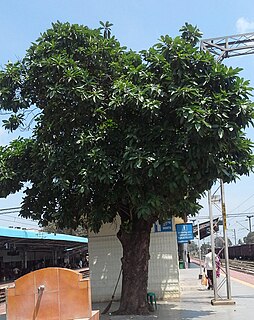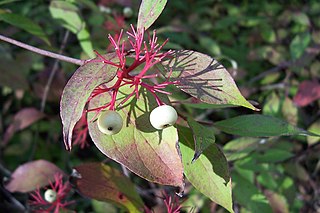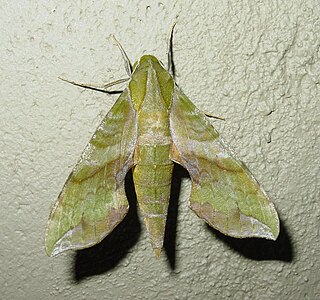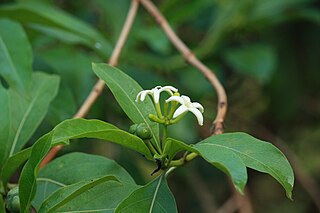
The Brassicales are an order of flowering plants, belonging to the eurosids II group of dicotyledons under the APG II system. One character common to many members of the order is the production of glucosinolate compounds. Most systems of classification have included this order, although sometimes under the name Capparales.

The Rubiaceae are a family of flowering plants, commonly known as the coffee, madder, or bedstraw family. It consists of terrestrial trees, shrubs, lianas, or herbs that are recognizable by simple, opposite leaves with interpetiolar stipules and sympetalous actinomorphic flowers. The family contains about 13,500 species in about 620 genera, which makes it the fourth-largest angiosperm family. Rubiaceae has a cosmopolitan distribution; however, the largest species diversity is concentrated in the tropics and subtropics. Economically important species include Coffea, the source of coffee, Cinchona, the source of the antimalarial alkaloid quinine, some dye plants, and ornamental cultivars.

Morinda citrifolia is a fruit-bearing tree in the coffee family, Rubiaceae. Its native range extends across Southeast Asia and Australasia, and was spread across the Pacific by Polynesian sailors. The species is now cultivated throughout the tropics and widely naturalized. Among some 100 names for the fruit across different regions are the more common English names of great morinda, Indian mulberry, noni, beach mulberry, and cheese fruit.

Morinda is a genus of flowering plants in the madder family, Rubiaceae. The generic name is derived from the Latin words morus "mulberry", from the appearance of the fruits, and indica, meaning "of India".

Morinda tinctoria, commonly known as aal or Indian mulberry, is a species of flowering plant in the family Rubiaceae, native to southern Asia.

The Hawaiian jungles are a tropical moist broadleaf forest ecoregion in the Hawaiian Islands. They cover an area of 6,700 km2 (2,600 sq mi) in the windward lowlands and montane regions of the islands. Coastal mesic forests are found at elevations from sea level to 300 m (980 ft). Mixed mesic forests occur at elevations of 750 to 1,250 m, while wet forests are found from 1,250 to 1,700 m. Moist bogs and shrublands exist on montane plateaus and depressions. For the 28 million years of existence of the Hawaiian Islands, they have been isolated from the rest of the world by vast stretches of the Pacific Ocean, and this isolation has resulted in the evolution of an incredible diversity of endemic species, including fungi, mosses, snails, birds, and other wildlife. In the lush, moist forests high in the mountains, trees are draped with vines, orchids, ferns, and mosses. This ecoregion includes one of the world's wettest places, the slopes of Mount Waiʻaleʻale, which average 373 in (9,500 mm) of rainfall per year.

Cornus sericea, syn. C. stolonifera, Swida sericea, red osier or red-osier dogwood, is a species of flowering plant in the family Cornaceae, native throughout northern and western North America from Alaska east to Newfoundland, south to Durango and Nuevo León in the west, and Illinois and Virginia in the east. It has sometimes been considered a synonym of the Asian species Cornus alba. Other names include red brush, red willow, redstem dogwood, redtwig dogwood, red-rood, American dogwood, creek dogwood, and western dogwood.

Morinda is a multi-level marketing company based in American Fork, Utah that sells Tahitian Noni juice and other products made from the noni plant. The company was founded in 1996 and has manufacturing facilities in Tahiti, Japan, China, Germany, and Utah. Morinda, formerly known as Tahitian Noni International and Morinda Bioactives, was a subsidiary of Morinda Holdings, Inc. prior to merging with and becoming a wholly owned subsidiary of New Age Beverages Corporation in December 2019.

Picea smithiana is a species of evergreen tree in the family Pinaceae family It is referred to by the common names morinda spruce and West Himalayan spruce, and is a spruce native to the western Himalaya and adjacent mountains, from northeast Afghanistan, northern Pakistan, India to central Nepal. It grows at altitudes of 2,400-3,600 m in forests together with deodar cedar, blue pine and pindrow fir.

Pakistan's native flora reflects its varied climatic zones, which range from arid and semi-arid to temperate and tropical.

Symphoricarpos albus is a species of flowering plant in the honeysuckle family known by the common name common snowberry. It is native to North America, where it occurs across much of Canada and the northern and western United States.

Xylophanes pluto, the Pluto sphinx, is a moth of the family Sphingidae. The species was first described by Johan Christian Fabricius in 1777.

Morindeae is a tribe of flowering plants in the family Rubiaceae. The tribe contains about 165 species in 5 genera, found mainly in the tropics and subtropics.
Alchornea hirtella is a shrub or small tree in the genus Alchornea in the family Euphorbiaceae. It is native to tropical Central and Southern Africa.
Rosenbergiodendron reflexum is a species of shrub in the family Rubiaceae. It is native to Peru.

Gynochthodes jasminoides is a woody climber or a scrambling shrub in the family Rubiaceae. In Australia it is found on the northern and eastern coasts, in Western Australia, the Northern Territory, Queensland, Victoria, and New South Wales.

Morinda coreia is a species of flowering plant in the coffee family, Rubiaceae. It was described by Francis Buchanan-Hamilton in 1822.

The Maldives-Lakshadweep-Chagos Archipelago tropical moist forests is a tropical moist broadleaf forest ecoregion in South Asia. It spans a chain of coralline islands in the Indian Ocean, including Lakshadweep, a union territory of India; the Maldives, an independent country; and the British Indian Ocean Territory, an overseas territory of the United Kingdom.

The Western Polynesian tropical moist forests is a tropical and subtropical moist broadleaf forests ecoregion in Polynesia. It includes Tuvalu, the Phoenix Islands in Kiribati, Tokelau, and Howland and Baker islands, which are possessions of the United States.

















